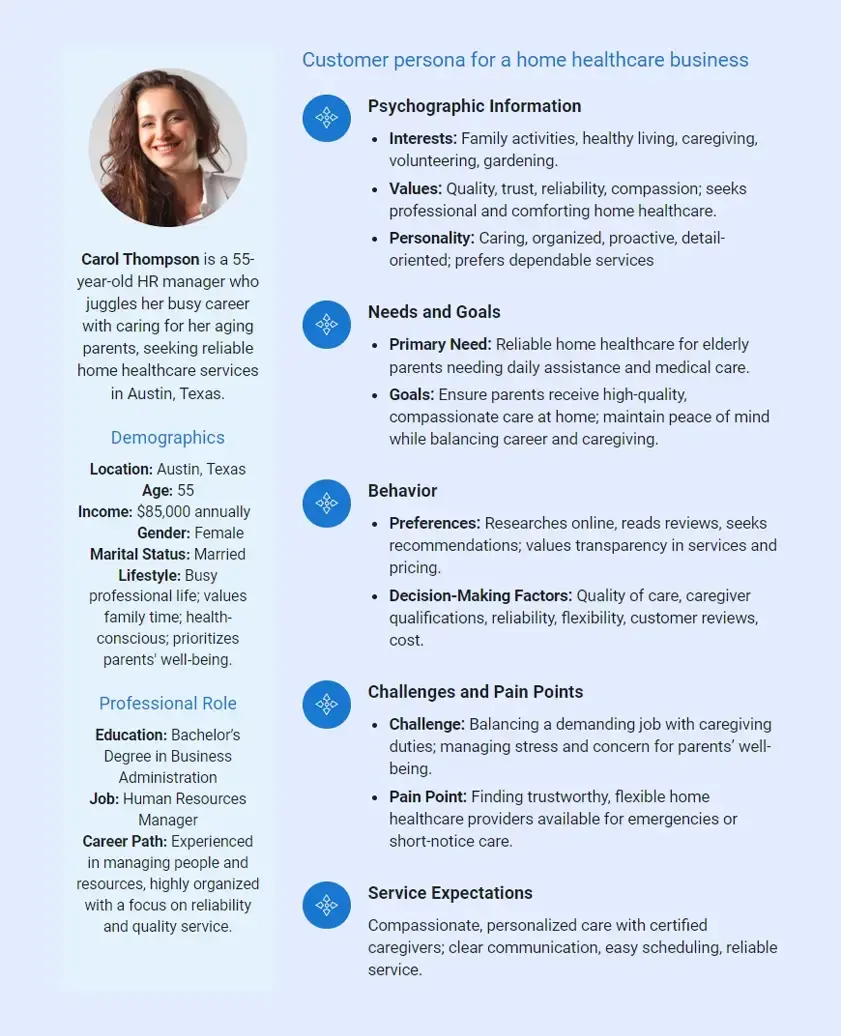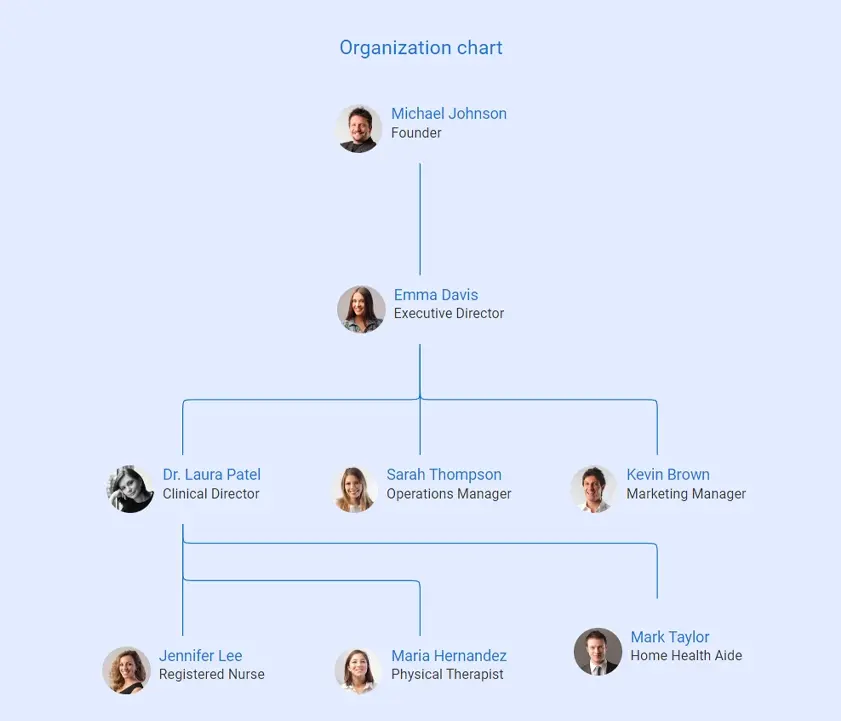The demand for quality home healthcare continues to grow with an aging population and a rising preference for in-home care.
As a result, the global home healthcare industry is booming—valued at $390.24 billion in 2023 and projected to expand further.
This shows a great opportunity for entrepreneurs looking to start a home healthcare business that makes a meaningful impact and has a strong growth potential.
However, it’s crucial to create an actionable business plan to attract investors and build a solid foundation for long-term success.
Need help drafting your plan? Not to worry!
This home healthcare business plan template will help you get started as well as understand how to write a successful business plan. But before that…
Importance of a home care business plan
Whether you’re an experienced home health care services provider or a beginner, you need a solid business plan. It serves as a strategic roadmap to successfully navigate the competitive home health care industry.
Check out these primary reasons why it’s essential:
- Clarifies the vision and mission of the home healthcare business as well as outlines strategic priorities, aligning everyone towards common goals.
- Provides comprehensive financial forecasts and budgeting that further helps in securing funding and managing cash flow.
- Gives valuable insights into the healthcare industry, target market, and competitive environment while allowing you to identify opportunities and differentiate services.
- Helps you identify the potential risks and challenges your healthcare business might face so you can develop mitigation strategies.
- Acts as an operational framework that helps you define the business structure, key roles, and processes required for efficient daily operations and quality patient care.
Now that you know the importance of a home healthcare business plan, it’s time to understand how to draft one.
How to write a business plan for home healthcare
Creating a home health care business plan involves several key sections to cover all your business aspects and strategies. Here’s a guide on how to write each component in detail:
1. Executive summary
An executive summary is a high-level introduction to your home health care agency as well as its concept and services.
Though it’s the first section of a home healthcare business plan, it’s written in the end once all the other sections are ready. Why? Because it summarizes the most essential elements mentioned in your plan.
Typically, your executive summary must include the following details:
- Business name, location, & its legal entity
- Mission and vision of your agency
- Market opportunities and your target audience
- Healthcare services you’ll offer (skilled nursing care, physical therapy, personal care, etc.)
- Promotional strategies
- Financial projections along with funding needs
In short, this section presents a quick, concise overview of your entire home healthcare business plan.
So, try to make it simple yet effective, capturing readers’ attention and persuading them to learn more about your business. Also, aim for a summary that is 1 or 2 pages in length.
Say goodbye to boring templates
Build your business plan faster and easier with AI
Plans starting from $14/month

2. Business overview
The business overview section provides a detailed explanation of your home healthcare company and its nature.
So, it’s a good opportunity to explain your business idea in detail and give readers an in-depth understanding of your home healthcare services.
Here’s a list of components that you should enclose in this section:
- Legal structure of your business (s-corp, LLC, or sole proprietorship)
- Business owners or partners
- Core values and vision statement
- Location & reason behind deciding that place
- Background history and milestones achieved (if any)
- Future goals along with the growth plans
In addition to that, discuss how your healthcare agency will comply with federal, state, and local regulations. Further, ensure you have licenses or certifications as well as discuss how you follow health and safety standards.
In simple terms, this section highlights all your business’s foundational facts and structural aspects that every potential investor or lender wants to know.
3. Market research
The market research section offers a clear snapshot of the external environment or sector in which your home health care company intends to operate.
This will help you get valuable insights into the market size and its growth potential, target audience, client needs and preferences, opportunities, challenges, healthcare industry trends, and competitors.
So, first, conduct thorough market research or analytical work to start and grow your home health care services successfully.
For instance, consider answering the following questions while planning this section:
- What’s the revenue of the global or national home health care market?
- How big is the home health care industry in the USA? Is it growing or declining?
- What’s the growth forecast for the next 5-10 years?
- Which are the top home healthcare agencies in the industry?
- What are the recent health care services trends in the market?
- Who are your potential clients in terms of their psychographic and demographic profiles?
If required, illustrate a detailed breakdown of your customer persona to specify the ideal client needs and preferences. Here’s an example:

By integrating such buyer persona segments, you show potential investors or stakeholders that you understand your target market better and satisfy their needs. Also, it helps you develop more focused strategies for growth and expansion.
4. Competitive analysis
The competitive analysis section emphasizes the competition (both direct and indirect) in your chosen marketplace.
Your direct competitors can be other home health care agencies. Besides, businesses that offer alternative services (such as assisted living facilities, nursing homes, occupational therapy, or non medical services) can be your indirect competitors.
But focus more on the direct competitors as they offer similar services as your. Analyze each competitor’s strengths and weaknesses, considering a few factors like their service offerings, client base, pricing models, as well as quality of home health aides and care.
This will help you determine where each competitor stands in the health care industry and identify the potential opportunities to differentiate your home health care service.
Overall, it’s an important aspect of market analysis that helps you explain your unique competitive advantage and develop strategies to position your home health care company effectively.
5. Marketing plan
Your home healthcare marketing plan summarizes the strategies you’ve planned to attract new customers and retain existing clients or patients.
A well-developed marketing plan allows you to create an effective promotional campaign and streamline your marketing efforts while maximizing brand awareness.
To plan this section, consider highlighting how you’ll promote your home healthcare services:
- Build a strong online presence through a professional website.
- Utilize social media platforms (Instagram, Facebook, LinkedIn) to share engaging content and client testimonials.
- Work with online press release distribution firms to develop your brand identity.
- Partner with hospitals, rehabilitation homes, senior centers, or medical professionals for referrals.
- Engage in direct email marketing campaigns to target local healthcare facilities and professionals.
- Participate in local community events, health fairs, or senior events.
Moreover, outline your client retention strategies and sales approach, such as free assessments, in-home consultations, loyalty programs, bundled service packages, discounts for new clients, or seasonal promotions.
6. Service offerings
This section is a comprehensive list of the home health care services that your agency will offer to its clients. It also represents your pricing strategy, including hourly rates, service packages, or subscription plans.
So, consider drafting the specific services you offer, such as:
- Skilled nursing services
- Physical therapy
- Occupational therapy
- Home health care aides
- Speech therapy
- Personal care
- On-call quality medical professionals
- Behavioral health
Additionally, mention specialized services that you plan to include, like employing occupational therapists or skilled nurses for unique service offerings.
After that, jot down how your home care business will fulfill the diverse needs of the aging population. Then clarify how your home health care services will differ from those provided by other home health care businesses.
7. Management team
The management team section highlights your home healthcare agency’s organizational structure as well as the key individuals responsible for daily operations and strategic planning.
It helps you weigh authority and show potential investors or stakeholders that your home health care business is led by a capable team.
So, briefly introduce the founders, managers, administrative staff, and healthcare professionals, including skilled nurses, caregivers, medical social workers, or other medical professionals. Also, include their roles & responsibilities, qualifications, and industry experience.
Furthermore, describe how each member will contribute to the success of your home health care business and the requirement of high-quality care for your clientele.
If applicable, create an organization chart that illustrates your company’s hierarchical structure and the relationships between key roles. For example:

8. Operations plan
The operations plan provides a detailed description of the day-to-day business processes and activities to run your home healthcare smoothly.
It means you need to explain how you’ll manage the operational intricacies and what it takes to run a home healthcare service on a daily basis.
Here’s a list of elements that your business operations plan section must include:
- Staffing requirements and training
- Operational processes, like client intake, scheduling, record-keeping, billing, etc.
- Customer service policies
- Technology and equipment used
- Office space and facilities
By detailing these operations aspects, you give readers a clear picture of the quality of your services and the necessary resources to ensure the success of your home health care business.
9. Financial plan
The financial plan is the most crucial aspect of your home health care business plan as it helps you showcase the financial viability and sustainability of your business.
So, in your home healthcare financial plan, consider providing a detailed analysis of your financial projections for the first 3-5 years of operation.
Also, outline your business’s revenue forecasts, pricing structure, and expected expenses (including salaries and medical equipment costs). Further, provide detailed financial statements and reports, such as:
Projected income statement
| Income Statement | Year 1 | Year 2 | Year 3 |
|---|---|---|---|
| Revenue | |||
| Service Revenue (Home Healthcare) | $500,000 | $600,000 | $720,000 |
| Total Revenue | $500,000 | $600,000 | $720,000 |
| Cost of Goods Sold (COGS) | |||
| Wages for Healthcare Professionals | $200,000 | $240,000 | $288,000 |
| Medical Supplies | $30,000 | $36,000 | $43,200 |
| Transportation Costs | $20,000 | $24,000 | $28,800 |
| Total COGS | $250,000 | $300,000 | $360,000 |
| Gross Profit | $250,000 | $300,000 | $360,000 |
| Operating Expenses | |||
| Salaries (Admin & Management) | $80,000 | $88,000 | $96,800 |
| Rent and Utilities | $30,000 | $31,500 | $33,075 |
| Marketing and Advertising | $15,000 | $16,500 | $18,150 |
| Insurance | $10,000 | $10,500 | $11,025 |
| Office Supplies and Miscellaneous | $5,000 | $5,250 | $5,513 |
| Total Operating Expenses | $140,000 | $151,750 | $164,563 |
| Operating Profit (EBIT) | $110,000 | $148,250 | $195,438 |
| Other Expenses | |||
| Interest Expense | $5,000 | $4,500 | $4,000 |
| Depreciation | $10,000 | $9,000 | $8,000 |
| Total Other Expenses | $15,000 | $13,500 | $12,000 |
| Net Profit Before Tax | $95,000 | $134,750 | $183,438 |
| Income Tax (30%) | $28,500 | $40,425 | $55,031 |
| Net Profit After Tax | $66,500 | $94,325 | $128,338 |
Cash flow statement
| Cash Flow Statement | Year 1 | Year 2 | Year 3 |
|---|---|---|---|
| Cash Flow from Operating Activities | |||
| Net Profit After Tax | $66,500 | $94,325 | $128,338 |
| Depreciation | $10,000 | $9,000 | $8,000 |
| Changes in Working Capital | -$5,000 | -$6,000 | -$7,000 |
| Net Cash Flow from Operations | $71,500 | $97,325 | $129,438 |
| Cash Flow from Investing Activities | |||
| Purchase of Equipment | -$20,000 | -$15,000 | -$10,000 |
| Net Cash Flow from Investing | -$20,000 | -$15,000 | -$10,000 |
| Cash Flow from Financing Activities | |||
| New Loan Proceeds | $50,000 | $0 | $0 |
| Loan Repayment | -$10,000 | -$10,000 | -$10,000 |
| Owner’s Equity Investment | $30,000 | $0 | $0 |
| Net Cash Flow from Financing | $70,000 | -$10,000 | -$10,000 |
| Net Increase in Cash | $121,500 | $72,325 | $109,438 |
| Opening Cash Balance | $20,000 | $141,500 | $213,825 |
| Closing Cash Balance | $141,500 | $213,825 | $323,263 |
Balance sheet
| Balance Sheet | Year 1 | Year 2 | Year 3 |
|---|---|---|---|
| Assets | |||
| Cash | $141,500 | $213,825 | $323,263 |
| Accounts Receivable | $40,000 | $48,000 | $57,600 |
| Equipment (Net of Depreciation) | $30,000 | $25,000 | $20,000 |
| Office Equipment | $10,000 | $9,000 | $8,100 |
| Total Assets | $221,500 | $295,825 | $408,963 |
| Liabilities | |||
| Accounts Payable | $15,000 | $18,000 | $21,600 |
| Short-term Loan | $10,000 | $0 | $0 |
| Long-term Debt | $40,000 | $30,000 | $20,000 |
| Total Liabilities | $65,000 | $48,000 | $41,600 |
| Equity | |||
| Owner’s Equity | $156,500 | $247,825 | $367,363 |
| Retained Earnings | $0 | $0 | $0 |
| Total Equity | $156,500 | $247,825 | $367,363 |
| Total Liabilities and Equity | $221,500 | $295,825 | $408,963 |
Moreover, don’t forget to mention funding needs and use of funds as well as enclose sensitivity analyses for different scenarios.
In short, a comprehensive and realistic financial plan lays out your home care business’s approach to securing funding, managing cash flow, and achieving break-even.
10. Appendix
In the home health care business plan appendix, you can attach any supporting documents that don’t fit into specific sections but support your plan. Such as:
- Resumes of key management team
- Market research data and surveys
- Copies of relevant licenses and certifications
- Samples of your marketing materials
- Letters of support or testimonial
- Names and makes of expensive medical equipment that will require large funding
- Details on affordable home health care policies you will provide
Simply put, this will add credibility and depth to your home healthcare agency plan. It also helps readers get the further understanding or validation of your business operations.
Download home health care business plan template
Ready to write your home health care business plan from scratch? But need more assistance with that? Look no further; download our free home health care business plan template pdf to start.
It’s a modern business plan template designed specifically for your home healthcare businesses. This sample business plan involves practical insights and examples that you may use as a guide for writing your own plan.
Conclusion
Now that you’ve a good idea of how to draft a home health care business plan and what to include in it, you can easily draft your very own business plan.
But if you’re still confused or looking for an easy way to develop your plan, consider using advanced business planning software. It helps you build an actionable business plan quickly and more effectively.
So, why wait? Start planning for your healthcare venture!




